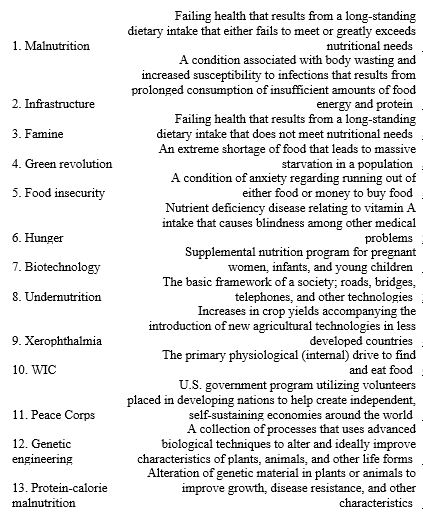A) poverty.
B) lack of technological advances.
C) cultural food preferences.
D) lack of large farms in developing countries.
F) A) and D)
Correct Answer

verified
Correct Answer
verified
Essay
Match the following with the descriptions below

Correct Answer

verified
Correct Answer
verified
Multiple Choice
What is the term to describe failing health that results from a long-standing dietary intake that either fails to meet or greatly exceeds nutritional needs?
A) Undernutrition
B) Overnutrition
C) Emaciation
D) Malnutrition
F) None of the above
Correct Answer

verified
Correct Answer
verified
Multiple Choice
Impaired development or function that results from an inadequate intake, absorption, or utilization of the nutrients needed for optimal growth, development, and body function is best termed
A) malnutrition.
B) undernutrition.
C) malabsorption.
D) hunger.
F) B) and D)
Correct Answer

verified
Correct Answer
verified
Multiple Choice
All of the following adversely affect the food/population ratio except
A) scientific advances that increase food production.
B) lack of birth control.
C) lack of food distribution methods.
D) lack of farmable land.
F) C) and D)
Correct Answer

verified
Correct Answer
verified
True/False
In terms of population migration and distribution, a movement from rural areas to urban areas tends to make the problem of undernutrition worse in the world.
B) False
Correct Answer

verified
Correct Answer
verified
Multiple Choice
All of the following are effects of semistarvation except
A) decreased energy level and strength.
B) poor concentration.
C) lack of hunger and appetite.
D) reduced immunity.
F) C) and D)
Correct Answer

verified
Correct Answer
verified
Multiple Choice
The acronym AIDS stands for ___________________________.
A) acquired immune deficiency syndrome
B) autoimmune deficit syndrome
C) antibiotic infection deficiency syndrome
D) anti-immune deficiency syndrome
F) A) and B)
Correct Answer

verified
Correct Answer
verified
Multiple Choice
Don is suffering from malnutrition. Which of the following might be true of his condition?
A) This means that he must be undernourished.
B) This means that he must be experiencing chronic hunger.
C) This means that he must be experiencing a vitamin deficiency.
D) He could be suffering from undernutrition or overnutrition.
F) None of the above
Correct Answer

verified
Correct Answer
verified
Multiple Choice
Which of the following is not true about AIDS?
A) It is transmitted in body fluids.
B) After infection with the HIV virus, AIDS symptoms generally begin showing within a year.
C) Eating a balanced diet cannot prevent or stave off HIV infection.
D) Eating a good diet cannot cure the disease.
F) C) and D)
Correct Answer

verified
Correct Answer
verified
Multiple Choice
Manipulating the DNA inside cells to improve production of materials or the material itself is called
A) social engineering.
B) translation.
C) transcription.
D) genetic engineering.
F) B) and C)
Correct Answer

verified
Correct Answer
verified
Multiple Choice
In light of its devastating toll on families, a big step toward alleviating poverty and hunger in sub-Saharan Africa and many other developing nations would be to limit the spread of
A) AIDS.
B) scurvy.
C) sickle cell anemia.
D) iron-deficiency anemia.
F) All of the above
Correct Answer

verified
Correct Answer
verified
Multiple Choice
The roots of undernutrition in the United States are mainly _______________, economic, and socioeconomic rather than technical. As policies of the federal government change, so does the problem of undernutrition.
A) agricultural
B) biological
C) political
D) nutritional
F) None of the above
Correct Answer

verified
Correct Answer
verified
Multiple Choice
Elements that adversely influence the food/population ratio include all of the following except
A) enhancing access to education for women.
B) war and political/civil unrest.
C) rapid depletion of natural resources.
D) AIDS.
F) A) and B)
Correct Answer

verified
Correct Answer
verified
Multiple Choice
Which of the following is the best approach to eradicating undernutrition in developing nations?
A) Have developed countries give direct food aid to underdeveloped countries
B) Improve the infrastructure of rural regions
C) Establish large farms
D) Provide more jobs in urban centers
F) B) and C)
Correct Answer

verified
Correct Answer
verified
Multiple Choice
The majority of hungry people live in
A) Africa.
B) Asia.
C) Latin America.
D) Europe.
F) All of the above
Correct Answer

verified
Correct Answer
verified
Multiple Choice
Failing health that results from a long-standing dietary intake that does not meet nutritional needs is termed
A) starvation.
B) undernutrition.
C) emaciation.
D) chronic hunger.
F) C) and D)
Correct Answer

verified
Correct Answer
verified
Multiple Choice
Which of the following is the best approach to preventing famine in developing nations?
A) Increase the productivity of rural people by teaching them farming methods so they can build agricultural surpluses to eat and sell.
B) Developed countries should send food and medicine.
C) Developing countries should grow cash crops.
D) Discourage having livestock.
F) B) and C)
Correct Answer

verified
Correct Answer
verified
Multiple Choice
Which of the following is true about acquired immune deficiency syndrome?
A) Mothers with AIDS should breastfeed their babies if the water supply is not safe for formula preparation.
B) AIDS reduces overall calorie needs.
C) AIDS is not an economic problem.
D) Developed nations, such as the United States, have the most infections.
F) None of the above
Correct Answer

verified
Correct Answer
verified
Multiple Choice
The Special Supplemental Nutrition Program for Women, Infants, and Children
A) provides breakfast for school children.
B) provides food vouchers and nutrition education to low-income pregnant and lactating women and their young children.
C) has not been shown to be cost-effective.
D) has not been shown to reduce the numbers of low-birth-weight babies.
F) A) and D)
Correct Answer

verified
Correct Answer
verified
Showing 21 - 40 of 61
Related Exams